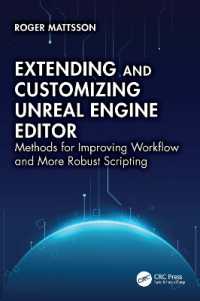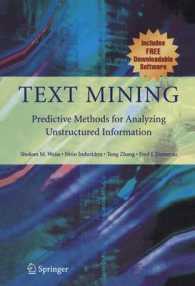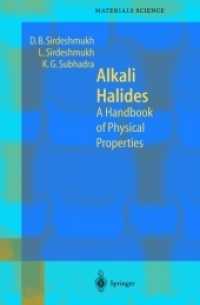基本説明
Recent and classic articles sample a broad range of topics including eyewitness testimony, memory, civil and criminal jury research, police investigations, lie detection, and false confessions.
Full Description
"Psychology and Lawcollection of articles which provides comprehensive coverage of the major areas in the field of civil and criminal experimental psychology and law. Recent and classic articles sample a broad range of topics including eyewitness testimony, memory, civil and criminal jury research, police investigations, lie detection, and false confessions. It will be essential reading for scholars and students wishing to study the intersection of psychology and law.
Contents
Series preface; Introduction; Part I Eyewitnesses, Memory, and the LawThe intoxicated witness: effects of alcohol on identification accuracy from show-ups, J.E. Dysart, R.C.L. Lindsay, T.K. MacDonald and C. Wicke; Over a decade of research on children's eyewitness testimony: what have we learned? Where do we go from here? G.S. Goodman and J.M. Schaff; Lineup and photo spread procedures: issues concerning policy recommendations, A.M. Levi and R.C.L.Lindsay; Memory faults and fixes, E.F.Loftus; Eyewitness performance in cognitive and structured interviews, A. Memon, L.Wark, A Holley, R. Bull and G. Koehnken; Witness confidence and witness accuracy: assessing their forensic relation, S. Penrod and B. Cutler; Eyewitness identification procedures: recommendations for lineups and photospreads, G.L. Wells, M. Small, S. Penrod, R.S. Malpass, S.M. Fulero and C.A.E. Brimacombe. Part II Police Investigations, Lie Detection and False Confessions: Who can catch a liar? P.Ekman and M. O'Sullivan; What is the current truth about polygraph lie detection, K.Fiedler J. Schmid and T. Stahl; On the psychology of confessions: does innocence put innocents at risk? S.M. Kassin; Detecting true lies: police officers' ability to detect suspects' lies, S. Mann, A. Vrij and R. Bull; What makes a good alibi? a proposed taxonomy, E.A. Olson and G.L. Wells Part III Jury Research: The effects of British and American trial procedures on the quality of juror decision-making, M.E. Collett and M.B. Kovera; Stealing thunder as a courtroom tactic revisited: processes and boundaries, L. Donik, T.I. Case and K.D. Williams; Permitting jury discussions during trial: impact of the Arizona reform, P.L. Hannaford, V.P. Hans and G.T. Munsterman; Discussion content and perception of deliberation in western European versus American juries, A.M. Martin, M.F. Kaplan and J.M. Alamo; Rethinking battered woman syndrome evidence: the impact of alternative forms of expert testimony on mock jurors' decisions, R.A. Schuller, E. Wells, S. Rzepa and M.A. Klippenstine; The effects of pretrial publicity on juror verdicts: a meta-analytic review, N.M. Steblay, J. Besirevic, S.M. Fulero and B. Jimenez-Lorente; On racial diversity and group decision making: identifying multiple effects of racial composition on jury deliberations, S.R. Sommers. Part IV Civil Forensic Issues: PTSD and the law of psychiatric injury in England and Wales: finally coming closer? M.C. Adamou and A.S. Hale; Psycholegal research on jury damage awards, E. Greene and E.F. Loftus; Mental health issues in long term solitary and 'supermax' confinement, C.Haney; Assessment of the commonsense psychology underlying Daubert: legal decision makers' abilities to evaluate expert evidence in hostile work environment cases, M. Kovera, M.B. Russano and B.D. McAuliff; Reducing variability in civil jury awards, M.J.Saks, L.A. Hallinger, R.L. Wissler, D.L. Evans and A.J. Hart. Part V Social Science and the Law: Psychology and legal change: the impact of a decade, C. Haney; Expert bias and partisanship: a comparison between Australia and Netherlands, M Malsch and I. Freckleton; Social science research in law: a new paradigm, J. Monohan and L.Walker; Social science and the courts: the role of amicus curiae briefs, R. Roesch, S.L. Golding, V.P. Hans and N.D. Reppucci; Expert witnesses, nonexpert witnesses and nonwitness experts, M.J. Saks; The expert witness, the adversary system, and the voice of reason: reconciling impartiality and advocacy, D.W. Shuman and S.A. Greenberg; Index.








